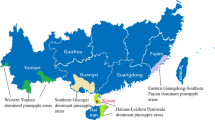Summary
Extensive artificial hybridisation among members of some 86 genera of vandaceous orchids within the subtribe Sarcanthinae in Singapore over the past five decades has created many thousands of exotic hybrids. A small number of these are selected for commercial cut-flower production, while others are cultivated as pot-plants. Two classes of intergeneric hybrids are of special commercial importance as export cut-flowers, the bigeneric Aranda (Arachnis x Vanda) and the trigeneric Mokara (Arachnis x Vanda x Ascocentrum) hybrids. Cytogenetic studies of these hybrids in recent years have provided information on the significance of ploidy levels and genomic constitutions on the horticultural performance of cut-flower cultivars, and also on the strategy for effective breeding in vandaceous orchids.
Similar content being viewed by others
References
Burkill, H.M., 1978. The role of Singapore Botanic Gardens in the development of orchid hybrids. In: E.S. Teoh (ed.), Orchids. Orchid Society of South East Asia, Singapore. pp. 38–41.
Dressler, R.L., 1981. The orchids—natural history and classification. Harvard.
Ede, A. & J. Ede., 1985. Living with orchids. MPH Publications, Singapore.
Eng, P.S., C.S. Loh, Y.H. Lee & C.S. Hew, 1984. Origin of some polyploid Aranda hybrids derived from Vanda Dawn Nishimura. Malaya Orchid Rev. 18: 98–101.
Goh, J., 1977. Preliminary studies on the postharvest longevity and bud opening of orchid inflorescences. B. Sc. Hons. Dissertation. Botany Department, National University of Singapore.
Goh, C.J. & L.G. Kavaljian, 1989. Orchid industry of Singapore. Economic Botany 43: 241–254.
Holttum, R.E., 1952. Hybridisation in Sarcanthinae: Its significance and limitations. Orchid Journal 1: 58–61.
Holttum, R.E., 1962. Aranthera Mohamed Haniff. Malayan Orchid Rev. 7: 21.
Johnson, H., 1990. What is a genus? An introduction to orchid classification. Malayan Orchid Rev. 24: 65–68.
Kamemoto, H., 1987. Chromosome technology in orchid breeding. Proc. World Orchid Hiroshima Symposium.
Kamemoto, H. & K. Shindo, 1964. Meiosis in interspecific and intergeneric hybrids of Vanda. Botan. Gaz. 125: 132–138.
Kirsch, M.O., 1963. Intergeneric hyblids in vandaceous genera. Proc. 4th World Orchid Conference. Singapore. pp. 98–103.
Koay, S.H., 1990. The Singapore orchid—opportunities and challenges. Malayaan Orchid Rev. 24: 85–87.
Koay, S.H., 1993. Overview of the Singapore orchid industry. Malayan Orchid Rev. 27: 73–75.
Lee, Y.H. & H. Kamemoto, 1986. Cytology and breeding behaviour of diploid and amphidiploid Aranda Wendy Scott (Orchidaceae). Proc. 5th Asean Orchid Congress, Ministry of National Development, Singapore.
Lee, Y.H., 1987. Cytology and fertility of an intergeneric orchid hybrid. J. Hered. 78: 319–322.
Lee, Y.H., 1988. Patterns of meiotic behaviour and sporad (spore tetrad) formation in some diploid Aranda hybrids. J. Hered. 79: 481–484.
Lee, Y.H. & F.Y. Tham, 1988. An advanced generation of Aranda orchids. Genome 30: 608–611.
Lee, Y.H., F.Y. Tham & W.L. Gwan, 1988. Origin and significance of polyploid Aranda and related hybrids. Proc. 1st International Symposium of Chromosome Engineering in Plants. China.
Lee, Y.H., 1990. Breeding aranda and mokara orchids of commercial cut-flowers. Proc. 3rd Asia Pacific Orchid Conference. Australia.
Lee, Y.H., 1991. Genomic constitutions and flower characteristics of selected Aranda orchid cultivars. Euphytica 54: 251–254.
Lee, Y.H., Y.P. How & J. Ede, 1991. Breeding polyploid Aranda orchids. Malayan Orchid Rev. 25: 82–87.
Lee, Y.H., 1994. Genomic and meiotic analysis of Mokara orchids. J. Hered. 85: 39–43.
Ng, H.G., 1984. Commercial orchid growing in Singapore—past and present. Malayan Orchid Rev. 18: 41–45.
Sheehan, T. & M. Sheehan, 1979. Orchid genera illustrated. van Nostrand Reinhold Co.
Tan, W.K., 1991. Vandaceous orchid hybridisation in Singapore. Proc. NIOC'91, Nagoya, Japan.
Tanaka, R. & H. Kamemoto, 1961. Meiotic chromosome behaviour in some intergeneric hybrids of the Vanda alliance. J. Amer. Bot. 48: 573–582.
Tanaka, R. & H. Kamemoto, 1974. List of chromosome numbers in species of the Orchidaceae. In: C.L. Wither (Ed.). The Orchid Scientific Studies, Wiley, pp. 411–483.
Teoh, E.S., 1979/80. Aranda as a parent. Malayan Orchid Rev. 14: 4–11.
Teoh, E.S., 1980. Asian orchids. Times Books International, Singapore, 287 pp.
Author information
Authors and Affiliations
Rights and permissions
About this article
Cite this article
Lee, Y.H., Wong, S.M., Tan, W.K. et al. Breeding vandaceous orchids for commercial cut-flowers in Singapore: an overview. Euphytica 89, 235–241 (1996). https://doi.org/10.1007/BF00034611
Received:
Accepted:
Issue Date:
DOI: https://doi.org/10.1007/BF00034611




